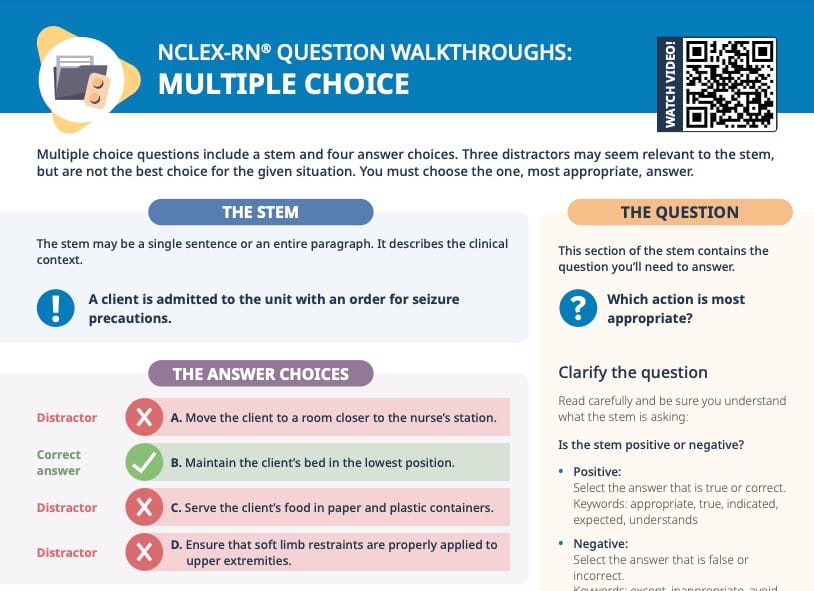Rephrase and understand the stem
This is a prioritization question: Which of the four patients needs the nurse’s attention most urgently, specifically for the issue of respiratory distress?
Recall what you know about abnormal respiratory assessments and respiratory distress
Clinical features of respiratory distress
- Mouth breathing
- Cyanosed/pale complexion
- Use of accessory muscles
- Tachypneic, characteristic sounds (wheezes, rhonchi, crackles, grunting)
Possible reasons for respiratory distress related to the presentation of the clients in the answer choices
- High blood sugar/diabetes: can lead to diabetic ketoacidosis (DKA) which can cause respiratory distress due to increased acidity in the blood
- Car accident: could cause injuries to chest/lungs (e.g. rib fractures or lung contusions) which result in pain and difficulty breathing
- COPD: often leads to respiratory distress due to airway obstruction and reduced lung function
- Stroke: could affect control of respiratory muscles leading to difficulties breathing
Go through the answer options: “eliminate + compare”
In your first pass through the answer options, focus on the basics: Is this patient at a high risk for respiratory distress – yes or no? For the answers you are not eliminating immediately, use a comparison system: For example, if patient A is at a high risk for respiratory distress, then compare them to answer B – Is this patient at a higher risk or at a lower risk? If lower, eliminate answer B, if higher, B becomes your new baseline for comparing the rest of the answers to.
Tip: It is vital you are clear about WHY you are eliminating an answer at all times. Use your scratch paper to note down your thoughts about each answer choice!
A. A client diagnosed with diabetes has a blood glucose value of 250 mg/gL after running out of insulin yesterday and is breathing quickly
Let’s keep an eye on this client for now, since even though a blood sugar of 250 is not exceptionally high, they could be on their way into DKA.
B. A client with respirations of 28 breaths/min and who takes shallow breaths and complains of chest pain after an auto accident that deployed the airbags
Since answer A was not immediately eliminated, let’s compare answer B to answer A. Client A is “breathing quickly,” but there is no actual number given. Client B, on the other hand, has a respiratory rate of 28, which is higher than the normal range for an adult. Adding the shallow breathing, the chest pain, and the history of a car accident where the airbags went off and hit the patient right in the chest, this patient is probably having more severe respiratory problems than client A. Let’s keep it for now.
C. A client with chronic obstructive pulmonary disease who is using pursed-lip breathing and has an oxygen saturation of 93% on room air
Now, compare this answer to the current “front runner,” answer B. While the pursed-lip breathing and oxygen saturation of 93% is not a good finding, COPD patients may have values like this on a very frequent basis. Assessing this client is necessary, but not more urgent than looking at the patient in answer B.
D. A client who just had a stroke, receives oxygen at 2 L via nasal cannula, has an oxygen saturation of 96%, and demonstrates dysarthria when trying to speak
Last, we will compare the client in answer D to the client in answer B, who, so far, is our priority.
The stroke is, of course, very significant and the client is getting oxygen through the cannula, but the oxygen saturation of this client is within normal range. Dysarthria when speaking is also not a sign of respiratory distress. This one can be eliminated as not urgent.
Therefore, the client in answer choice B is the highest priority to evaluate for respiratory distress, and is the correct answer.
Recap
The client in answer B has been in a car accident receiving a direct hit to their chest wall. The person is breathing fast and shallow, reporting pain, which shows you they are already getting into distress. This is the client you should see first.

